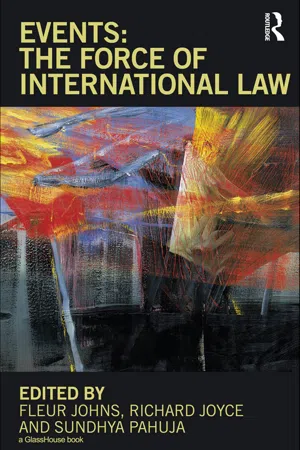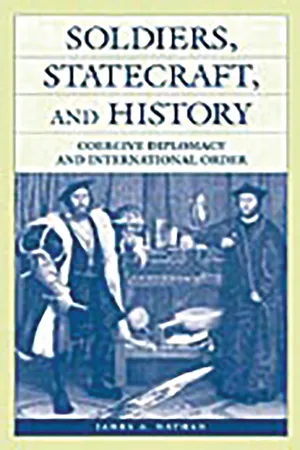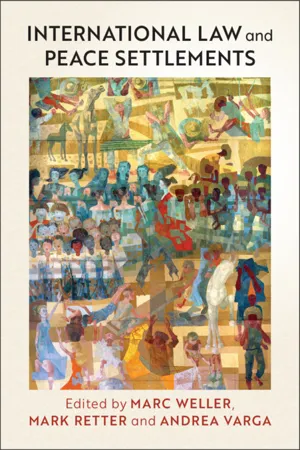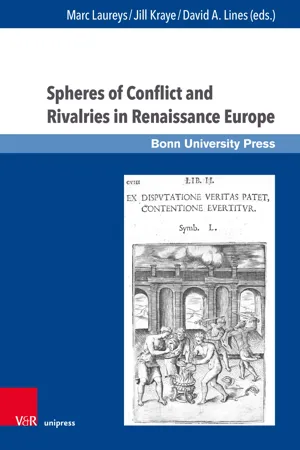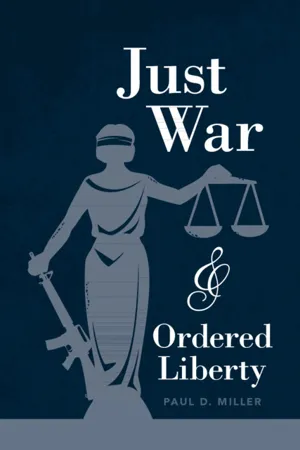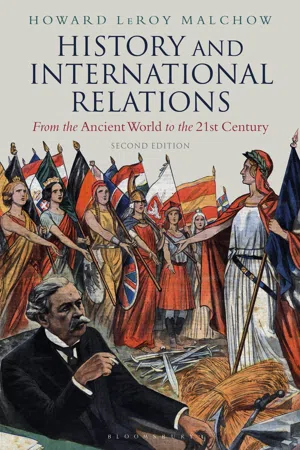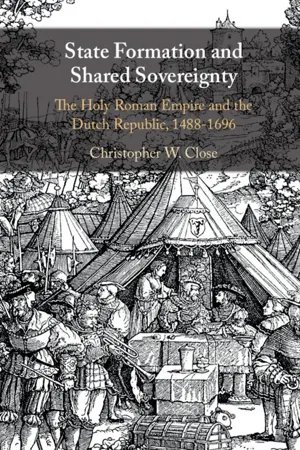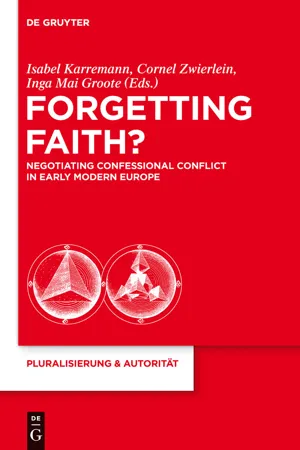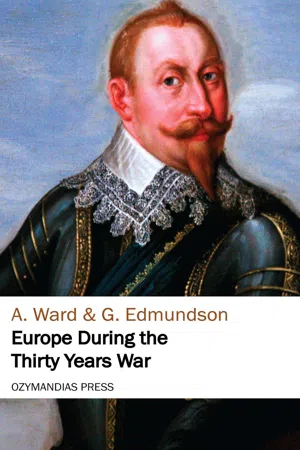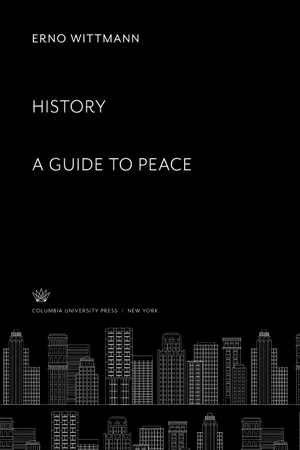History
Peace of Westphalia
The Peace of Westphalia, signed in 1648, marked the end of the Thirty Years' War in the Holy Roman Empire and the Eighty Years' War between Spain and the Dutch Republic. It is considered a landmark in the development of the modern state system, as it established the principle of state sovereignty and the idea of coexisting sovereign states in Europe.
Written by Perlego with AI-assistance
Related key terms
1 of 5
11 Key excerpts on "Peace of Westphalia"
- eBook - ePub
- Fleur Johns, Richard Joyce, Sundhya Pahuja, Fleur Johns, Richard Joyce, Sundhya Pahuja(Authors)
- 2010(Publication Date)
- Taylor & Francis(Publisher)
Westphalia Event, memory, myth Richard Joyce[T]he origin makes possible a field of knowledge whose function is to recover it, but always in a false recognition … The origin lies in a place of inevitable loss. (Foucault 1977: 143)Introduction
The Peace of Westphalia of 1648 is routinely cited as the ‘event’ which marks the emergence of the modern sovereign state. From this point on, so the story goes, states are freed from religious and imperial rule and now provide the basis for their own authority. In doing so, they ground the existence and authority of international law. This event thus looms large in the international legal memory as its foundational moment.However, the notion that the Peace marked a decisive break between medieval notions of political authority and the modern states system has been called into question. The debate is keenest in the field of international relations. For Stephen Krasner, the ‘widely held view among international relations theorists and international lawyers which sees Westphalia as a major, perhaps a decisive, break marking the transition from the medieval to the modern world’ – a world now divided into sovereign states – ‘is wrong’ (Krasner 1993: 235, 238). As Krasner points out, political entities with more or less exclusive control over defined territories existed well before the Peace, and medieval forms of political authority – including authority exercised by the Holy Roman Empire and the papacy – continued well after it (Krasner 1993; see also Beaulac 2004). Responding to this debunking of the conventional view, Daniel Philpott has attempted to ‘rescue’ the ‘prestige of Westphalia’ by once again establishing its place at ‘the origin of modern international relations’ through an ‘updated defense, more subtle and qualified than the conventional wisdom’ (Philpott 2001: 76–77). Philpott accommodates the existence of elements of sovereignty prior to Westphalia by characterizing it as ‘the consolidation, not the creation ex nihilo - eBook - PDF
Soldiers, Statecraft, and History
Coercive Diplomacy and International Order
- James A. Nathan(Author)
- 2002(Publication Date)
- Praeger(Publisher)
Sometime in its third decade, it became clear that the Thirty Years War had become a struggle between contending visions of international order: The first might be based on sovereign, independent dominions; the second would be based along medieval lines on religious faith and universal au- thority. In the general defeat of the Hapsburgs, the latter theory was de- molished.' 1 * The formal settlement of the Thirty Years War at the Congress of Westphalia heralded the onset of what we now call the "classic" period of international diplomacy. The Congress of Westphalia was the first such meeting of its kind: Great numbers of "accredited" diplomatic representatives, plenipotentiaries, and clerics from over 96 entities assembled in two cities thirty miles apart— Osnabruck and Miinster. The whole area of Westphalia was a kind of demilitarized zone, surrounded by a hunger so pervasive that criminals feared their famished warders more than any jail. The envoys met contin- uously from 1642 to 1648. Years were consumed by squabbles over ab- struse claims which served to befog their hope that ongoing battles, raging *As Derek Croxton points out, the division, like any episode in history, is not a divide but is, on closer inspection, not as clear-cut as commentators would have it in retrospect, especially as to the issue of "sovereignty" which, in the English, French, and Swedish instances, was more developed than it was in Germanic signatories of the Westphalia Accords. "The Peace of Westphalia and the Origins of Sovereignty," paper delivered on the occasion of the 350th anniversary of the Peace of Westphalia, Enschede, 1998. Westphalia and the Rise of Modern Diplomacy 3 on fronts as near as three days' hard ride and as distant as the coast of Ceylon, would compel terms which the negotiators would not otherwise concede. Time was required to fashion what would be, in their words, a "once and for all" settlement. - eBook - PDF
- Marc Weller, Mark Retter, Andrea Varga(Authors)
- 2021(Publication Date)
- Cambridge University Press(Publisher)
Frankreich, das Alte Reich und Europa (17.-18. Jh.)’, in Eva Dewes and Sandra Duhem (eds.), Kulturelles Geda ¨chtnis und interkulturelle Rezeption im europa ¨ischen Kontext (Berlin: Akademie, 2007), 89, at 91–3. 51 Martin Wrede, ‘Das Reich und seine Geschichte in den Werken franzo ¨ sischer Staatsrechtler und Historiker des 18. Jahrhunderts’ (2000) 27 Francia 177, at 191–4. The Treaty of Westphalia As Peace Settlement and Political Concept 73 (and the Peace Treaty of 1648 contained numerous provisions on minor issues) had to remain unchanged – even if they became completely obsolete over time. 52 4.3.2 Solidissimum fundamentum mutuæ amicitiæ tranquillitatisque: the Solemn Affirmation of Westphalia in French Treaties with the Empire France’s commitment to act as guarantor of the Westphalian Peace Treaty and maintain its political and (if necessary) military presence after the 1648 peace was a key factor for many Imperial estates in overcoming their deep mistrust and joining the Treaty. During the reign of Louis XIV, this political role even gained major importance in the self-portrayal of the French King. In the panegyrical literature, Louis XIV was celebrated as the universally acknowledged Arbitre de la Paix et de la Guerre of the Holy Roman Empire and protector of the liberty of the German estates – a position which had been conferred solemnly onto the French Monarch through the Westphalian Treaty. 53 The Treaty’s significance for French reputation becomes apparent upon examining the treaties concluded after 1648 between France and the Holy Roman Empire, as well as those between France and the German Estates – more specifically, the way in which the Peace of Westphalia was reaffirmed in these treaties. In general, it was not unusual at the time for contracting powers to confirm their previous bilateral peace treaties in special clauses when they entered into a new peace treaty, usually by listing these older treaties – or at least some of them – by name. - Available until 15 Jan |Learn more
Strategies for Peace
Contributions of International Organizations, States, and Non-State Actors
- Volker Rittberger, Martina Fischer, Volker Rittberger, Martina Fischer(Authors)
- 2008(Publication Date)
- Verlag Barbara Budrich(Publisher)
The Westphalian system did not initiate a period of stable peace. On the contrary, Westphalia established a state-centered system defined by an end-less cycle of ‘hot’ war and ‘cold’ peace. Looking at the subsequent record of European and world history after 1648, the Westphalian system, as it has 1 Krasner is correct to argue that it would be historically inaccurate to state that the Westpha-lian treaties generated the ‘Westphalian model’ of international relations (Krasner 1999: 20). Starting from 1648, it took some 100 years until the norm of sovereignty became pre-valent in European politics and another 100 years until it became valid as an ordering prin-ciple in world affairs through European colonialism. Nonetheless, the conceptual founda-tions of the model were laid down in the Treaties of Westphalia. 2 For a thoughtful and critical review of this broadly accepted notion, see Teschke (2003). 3 For a comprehensive analysis of the concept of ‚sovereignty’, see Krasner (1999). Accor-ding to Krasner, sovereignty can be distinguished into four different dimensions, namely international legal sovereignty, Westphalian sovereignty, domestic sovereignty, and inter-dependence sovereignty (see Krasner 1999: 9ff). Westphalian sovereignty is based on two principles: territoriality and the exclusion of external actors from internal authority arrange-ments (Krasner: 20ff). Since it has been widely recognized, but also frequently violated through contract, convention, coercion and imposition, Krasner concludes that sovereignty is a form of ‘organized hypocrisy’ (Krasner 1999: 69). 27 been referred to in the scholarly literature, has known no shortage of wars of every kind. Between 1650 and 1945, the empirical records show that both the number and scope of violent conflicts have risen steadily (Kegley/Raymond 2002: 139). - Marc Laureys, Jill Kraye, David A. Lines, Marc Laureys, Jill Kraye, David A. Lines(Authors)
- 2020(Publication Date)
- V&R Unipress(Publisher)
© 2020, Vandenhoeck & Ruprecht GmbH & Co. KG, Göttingen ISBN Print: 9783847106272 – ISBN E-Book: 9783847006275 Peter Arnold Heuser The Peace Congress of Westphalia 1643–1649 as a Sphere of Conflict and Rivalries Abstract In the Westphalian cities of Munster and Osnabruck, the Peace Congress of Westphalia worked out a series of peace treaties signed in 1648. These treaties ended the Eighty Years’ War (1568–1648) between Spain and the emerging Dutch Republic, and the Thirty Years’ War (1618–1648) in the Holy Roman Empire. They established the independence of Switzerland from the Empire and changed the system of political order in Europe. For nearly half a decade, between 1643 and March 1649, the congress brought together a total of nearly 300 envoys (ambassadors, residents, agents), representing European powers and Imperial estates of different size and political importance. Their peace negociations and their interactions constituted a distinct sphere of diplomatic conflicts and rivalries, with complex external relations to the European capitals, to political leaders and political fac- tions in different parts of Europe. This contribution sketches a typology of these conflicts and rivalries, depicts the forms of communication and media the actors used, describes how their intellectual backgrounds influenced their “Streitkultur” and deals with the techniques that the congress developed to overcome or at least to neutralize conflicts and rivalries in favour of an overall peace agreement. Introduction Negotiated simultaneously in the two Westphalian cities of Munster and Os- nabruck, the Peace Congress of Westphalia (1643–1649) 1 worked out a series of peace treaties signed between January and October 1648 at Munster. These treaties not only ended the Thirty Years’ War (1618–1648) 2 in Central Europe, but 1 As an introduction, see Dickmann (1998); Duchhardt, ed. (1996); Duchhardt, ed. (1998); Repgen (1998a); Repgen (1999); Croxton / Tischer (2002); Bosbach (2011).- eBook - PDF
- Paul D. Miller(Author)
- 2021(Publication Date)
- Cambridge University Press(Publisher)
4 The Westphalian Tradition The Protestant Reformation and the ensuing Wars of Religion fractured the religious consensus in Western Christendom and made urgent the search for new grounds on which to base claims of political legitimacy and the use of force. The Peace of Westphalia marked a sea change in the political order of Europe, codifying religious pluralism and a multipolar order and rejecting the aspiration of a religiously homogenous universal empire. The Treaty of Osnabrück, one of a trio of treaties codifying the Westphalian settlement, specified that, “adherents of the Augsburg Confession [i.e., Lutherans] who are subjects of the Catholics, and the Catholic subjects of the estates of the Augsburg Confession . . . shall be patiently tolerated and have liberty of conscience.” It specified religious minorities’ rights to public-worship services, religious education for their children (even education abroad), and their freedom from employment discrimination on the basis of their faith: “In these and all other similar things, they shall be treated in the same manner as brethren and sisters with equal justice and protection.” The treaty specifically barred resump- tion of warfare on grounds of religion: in cases of religious dispute, “the dispute is to be decided by amicable agreement alone.” 1 These and other provisions effectively declared that differences of religion were to be tolerated within and between nations, abandoning the ideal of a religiously unified Christian Europe that had animated much of European political aspirations since Constantine. The Renaissance had prepared the ground by recovering pre-Christian influences on Western thought, influences which thinkers turned to as a resource for rebuilding the social order in the absence of religious uniformity. - eBook - PDF
History and International Relations
From the Ancient World to the 21st Century
- Howard LeRoy Malchow(Author)
- 2020(Publication Date)
- Bloomsbury Academic(Publisher)
But this was in fact a limited freedom—they could not wage offensive war, and continued to be subject to the jurisdiction of imperial legal institutions. It is hard to justify the common assertion that the settlement directly enabled a system (and doctrine) of sovereign balancing, or that it legitimated the view that these principalities were in fact henceforth fully sovereign. At the most, according to Wilson, it further “eroded” the medieval principle of hierarchy and was “a major step” toward a modern system of formal equality among sovereign states. At the same time, it may be argued that a practical effect of the peace was to save, clarify, and somewhat enhance Austrian Habsburg authority that had waned significantly in the previous century. As Wilson concludes, Westphalia “injected new life into [the Empire’s] constitution and strengthened its political culture” (Wilson, 2009, 672, 769, 778). The “Myth” of Westphalia …the Treaty of Westphalia … made the territorial state the cornerstone of the modern state system. (Hans Morgenthau, 1948) The actual institution of the balance of power … was an implicit objective of the Peace of Westphalia of 1648, which marked the end of Habsburg pretensions to universal monarchy. (Hedley Bull, 1977) …the shift in Europe from the medieval world to the modern international system … took full shape at the Peace of Westphalia in 1648. (Daniel Phillpot, 2001) The debate over Westphalia in IR scholarship intensified with the assault on Realism and Neorealism in the eighties and nineties, and continues. While scholars would likely - eBook - PDF
State Formation and Shared Sovereignty
The Holy Roman Empire and the Dutch Republic, 1488–1696
- Christopher W. Close(Author)
- 2021(Publication Date)
- Cambridge University Press(Publisher)
Negotiated over several years in the towns of Osnabrück and Münster, the Peace gave the Dutch Republic practical recognition of its independence, established amnesty for the war’s participants, granted territorial concessions to Sweden in the Empire’s north, and expanded and modified many of the Religious Peace’s stipulations that governed life in the Empire. The Peace of Westphalia also revoked the Edict of Restitution and set 1624 as the new normal year, which ensured that Maximilian of Bavaria retained his electoral title and the Upper Palatinate. At the same time, it created an 88 Quoted in Schluze, Reichskreise, 506. 89 Unpartheyisches Bedencken, 79. 90 Unpartheyisches Bedencken, 56–8. 91 Unpartheyisches Bedencken, 63. Alliance in the Empire and the Peace of Westphalia 303 eighth electorship for Friedrich V’s descendants, who returned to Heidelberg as rulers of the Lower Palatinate. This measure, crucially important for Protestants, was complemented by provisions calling for reform of imperial courts and eliminating majority rule in the Imperial Diet for matters of religion. 92 In the process, central demands of the Protestant Union’s Gravamina finally found their way into imperial law decades after the Union’s demise. The Peace of Westphalia also addressed the status of alliances. Article VIII confirmed the “ancient rights, authorities, freedoms, and privileges” of Imperial Estates and strengthened their ability to intervene in the Empire’s affairs through the Imperial Diet. In addition, it reaffirmed the “perpetual” right of each member of the Empire “to create and establish alliances for their preservation and security, either among themselves or with foreign potentates. Such alliances must not be directed against the emperor, the Empire and its public peace, or especially against this treaty. Nor must they violate in any way the oaths that bind Estates to the emperor and Empire.” 93 This formula marked a compromise among the negotiating parties. - eBook - PDF
Forgetting Faith?
Negotiating Confessional Conflict in Early Modern Europe
- Isabel Karremann, Cornel Zwierlein, Inga Mai Groote, Isabel Karremann, Cornel Zwierlein, Inga Mai Groote(Authors)
- 2012(Publication Date)
- De Gruyter(Publisher)
Both treaties (in the original Latin and in several historical translations) may be found at the excellent website http://www.pax-westphalica.de/index.html. The quote here is from article 2 of the Treaty of Osnabrɒck – http://www.pax-westphalica.de/ipmipo/index.html (accessed 22 June, 2011). In the body of the text below, I quote the IPO by Article and section after this site. member the “Hostilities” of the Thirty Years’ War they have been con-vened to forget before they will be permitted to cross over into a more peaceful ‘oblivional’ time. 3 For, just as in our famously post-secular twen-ty-first century world, so too in the Treaty, religion in general and the specific “Troubles” often said to have been at the heart of the century of religious conflicts that beset early modern Europe “live on […] beyond [their] prematurely announced and celebrated death” in the very terms of the amnesty the Treaty was meant to bring about (de Vries 2006, 7). I return to the afterlife of religion in the Peace of Westphalia below. What bears noting here is the similarity of the issues confronting the early modern Westphalian and our own post-modern – even “post-West-phalian” 4 – eras, first and foremost the challenge of negotiating religious pluralism in the public sphere precisely as a matter of negotiation rather than at the end of the barrel of a gun. It is this challenge that invests the project of remembering Westphalia with particular urgency today. It is of course also the issue that endows the essays collected in the present vol-ume with their special timeliness. The dizzying nature of the periodization dynamic called up by such apparently clear epochal parallels is nevertheless daunting, and no won-der. - eBook - ePub
- A. Ward(Author)
- 2018(Publication Date)
- Ozymandias Press(Publisher)
France and Sweden would gladly have lessened the prestige of the House of Austria by introducing into the constitution of the Empire a provision that henceforth no election of a Roman King should be held during the lifetime of an Emperor. They were also desirous of augmenting the power of the Estates at large, among whom Sweden was now herself to be numbered; and France hoped to exercise an enduring influence, by making their assent requisite for the holding of any such election, and for the settlement of a permanent Wahlcapitulation limiting the Imperial authority. But the Austrian diplomacy succeeded in holding over the consideration of these matters for the next Diet. On the other hand the two Powers were able to delay the actual conclusion of the Peace for some time after its articles were complete by long discussions as to the proper ways of executing and of securing it. The Peace was actually signed at both Münster and Osnabrück on October 27, 1648; but, though the Emperor’s edicts for its execution were issued -a fortnight afterwards, the ratifications were not exchanged till February 8, 1649. Meanwhile the exchange of prisoners and other matters appertaining to the execution of the Treaties had been taken in hand by the military commanders, and were not wound up till June, 1650, at Nürnberg. The protest which the Papal Nuncio had offered against the Peace immediately after its conclusion, was reiterated a month later by Pope Innocent X in the Bull Zelo domus Dei (November 26, 1648); but its validity had been denied beforehand in the Peace itself, and no proceeding could have demonstrated more palpably the complete estrangement which now prevailed between the Imperial and the Papal authority. As a matter of fact, the Papal protest is not known to have been ever invoked by any Power against any stipulation of the Peace of Westphalia.Each of the two Powers, whose alliance had prolonged the War, might now seem to have achieved its ends. The statesmanship of Sweden, hardly less than the heroic deeds of her great King and a succession of eminent commanders, had obtained for her the position of a great European Power. But her losses in men were so serious, that a war on a similar scale could hardly be contemplated by the living or the next generation; while the monarchy could only defray the financial cost of the effort by processes which ended in changing the bases of Swedish constitutional life. The Swedish Crown had acquired a fair German province which provided the security desired by both Gustavus Adolphus and Oxenstierna for the kingdom itself and for the sufficiency of its share in the control of the Baltic. Sweden hereby also secured a permanent right to a participation in the affairs of the Empire, which might at any time be used for the purpose of once more gaining the control of them. But she had to reckon with the jealousy of her new neighbour Brandenburg as well as with old Scandinavian enmities; and the maintenance of the position which she at present held among the States of Europe could not be regarded as definitely assured. - eBook - PDF
- Erno Wittmann(Author)
- 2019(Publication Date)
- Columbia University Press(Publisher)
The order remains nebulous. The various hierarchies and independent states tolerate the domination of some one Great Power by co-operating in its policies, but never admit that they have a boss or are bound to follow its commands. When peace is concluded, when a new order of rank is established or the old re-stored, this object is not attained by any clear-cut written dispositions. In 1714, when the war against Louis X I V ended in the Treaty of 2 3 4 P E A C E A G R E E M E N T S Utrecht, France was defeated and her expectations of uniting Europe in a single Roman Catholic monarchy were checked. A new order, with England as balancer, began to emerge. The United Provinces abdicated from their rule as maritime overlords, and England took command, but it was a de facto change; no well-drafted articles in the treaty expressed it. 1 Nor will one find any order of rank created among states by the Congress of Vienna or the Paris conferences of 1918. The new order of all states, or the re-established old one, is a de facto product of the dynamic balance worked out after a general revolution as the after-math of the war. The peace treaty contains at most terms establishing a provisional domination of the defeated, or general rules providing a method by which agreement is to be reached in the case of other conflicts of interest. Napoleon's defeat was followed by a temporary occupation of France and an agreement that future conflicts would be settled by conferences between the Great Powers, to be convened from time to time. The defeat of Wilhelm II was followed by a tem-porary occupation of Germany and the creation of a League of Nations. The line between the two kinds of wars—those for minor, well-defined adjustments and those for an order of rank—cannot be sharply defined. Even wars for limited objectives demonstrate clearly which belligerent is the stronger and thus enhance or diminish the prestige of both parties.
Index pages curate the most relevant extracts from our library of academic textbooks. They’ve been created using an in-house natural language model (NLM), each adding context and meaning to key research topics.
